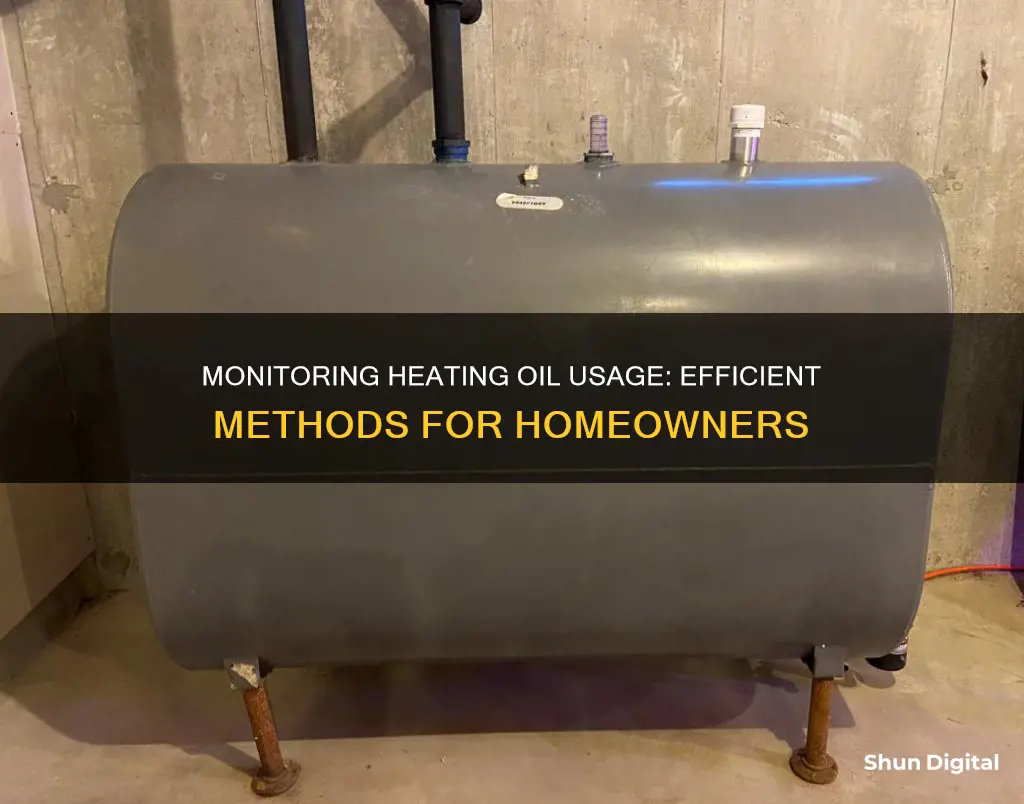
Monitoring heating oil usage can help you save money and control your energy use. There are various ways to do this, from simple methods like manually monitoring the burner for an hour to calculate average daily consumption, to more advanced methods like installing a smart meter or tank monitor. These devices can provide real-time data on fuel usage and levels, and even alert you when levels are low or if there is a sudden drop, indicating theft or tank failure. With the help of technology, you can make informed decisions about your heating oil usage and take steps to optimise your consumption.
| Characteristics | Values |
|---|---|
| Purpose | To monitor heating oil usage to ensure you’re getting the most heating oil for your money |
| Factors affecting oil usage | Weather conditions, size of the oil tank, thermostat setting, outdoor temperature, wind conditions, building insulation level, building air tightness, oil burner nozzle size, oil burner fuel unit pumping pressure, oil burner efficiency, oil burner cycling rate |
| Manual monitoring method | Monitor the oil burner for an hour, average the total amount of time it operates, multiply by 24 to determine daily usage, multiply by the unit’s advertised gallons of oil per hour ratio to assess daily consumption |
| Tank monitoring systems | Beckett Rocket Wireless Gauge, EnerTracSE, Independent Technologies-Wesroc, SkyBitz Tank Monitoring, Tank Utility, Paygo |
| Tank monitor features | Display inside the home, transmitter and receiver unit, alarm for low fuel levels, historical cost data, "days to empty" feature, fuel theft alert, app for consumption data analysis, cloud-based software |
What You'll Learn

Monitor your heating oil consumption by timing your burner
Monitoring your heating oil consumption can be done by timing your burner. This method involves monitoring the burner for an hour and timing how long it operates within that time frame. Repeat this process later in the day and average the total amount of time the burner operates over the course of an hour.
To determine the average, take the total amount of time the burner was in operation and divide it by two. For example, if the burner was in operation for 30 minutes during the first hour and 40 minutes during the second hour, the average would be 35 minutes.
Once you have the average, multiply it by 24 to determine how many minutes the burner operates each day. In this case, the burner would operate for a total of 840 minutes per day (35 x 24 = 840).
Finally, multiply the result by the unit's advertised gallons of oil per hour ratio to assess how many gallons of oil your home consumes in a day. For example, if your burner operates at 1 gallon of oil per hour, your daily consumption would be 840 minutes x 1 gallon per hour = 840 gallons of oil per day.
This method provides a general estimate of your heating oil consumption and can help you monitor your usage and make adjustments as needed.
Monitoring Comcast Data Usage: Tips and Tricks
You may want to see also

Calculate how much oil your home consumes in a day
To calculate how much oil your home consumes in a day, you can use the following method:
Firstly, monitor your oil burner for an hour, timing how long it operates within that time frame. Repeat this process later in the day, monitoring the burner for another hour. Take the average of the total amount of time the burner operates over the course of an hour, and multiply this by 24 to determine how many minutes the burner operates each day.
Next, you will need to know the number of gallons of oil your burner uses per hour. This information can be found on the data plate of your boiler or furnace. Multiply the number of gallons of oil used per hour by the number of minutes the burner operates in a day (as calculated in the previous step). This will give you the total number of gallons of oil your home consumes in a day.
For example, let's say that your burner operates for 30 minutes over the course of an hour. Multiplying this by 24 gives us 720 minutes of operation per day. If your data plate states that your burner uses 1 gallon of oil per hour, multiplying this by 720 minutes gives us 720 gallons of oil consumed per day.
It is important to note that this calculation provides an average daily consumption and does not account for fluctuations due to changes in weather conditions or other factors. As such, your actual daily oil consumption may vary.
Additionally, there are other methods to estimate your daily oil consumption, such as using historical data or comparing your home to similar homes in the area. You can also contact a heating oil delivery company to request an estimate.
Monitoring Wi-Fi Usage on iPhone: A Step-by-Step Guide
You may want to see also

Compare heating oil prices and buy in bulk
When it comes to heating oil, buying in bulk can be a great way to save money. Here are some tips on how to compare heating oil prices and make bulk purchases:
- Monitor your usage: Before buying in bulk, it's important to understand your household's oil consumption. Monitor your burner for an hour, noting how long it operates. Repeat this process later in the day and calculate the average daily usage. This information will help you determine how much oil to purchase.
- Compare prices: Use heating oil comparison websites or contact local suppliers directly to get quotes. Websites like FuelSnap and HeatingOil.co.uk allow you to compare prices from different suppliers in your area. You can also check out MoneySavingExpert's list of heating oil brokers and comparison sites.
- Time your purchase: Typically, heating oil demand is lower in summer, driving prices down. So, it's generally a good idea to buy in bulk during the summer months. However, keep an eye on near-term pricing predictions and weather forecasts, as harsh winters may require more heating oil.
- Haggle for discounts: Don't be shy to haggle! Contact suppliers and ask if they can beat the quotes you've received from their competitors. The more oil you order, the better the discount you're likely to get.
- Join a buying group: Consider joining or creating a buying group in your area. Group purchases often result in better deals since suppliers save on delivery costs by making fewer trips to the same area. Websites like BoilerJuice, CheapestOil, and Fueltool can help you connect with other buyers.
- Lock in prices: Take advantage of services that allow you to lock in heating oil prices. For example, FuelSnap lets you lock in heating oil prices in certain areas. This can protect you from price fluctuations and ensure you get the best value.
- Buy from reputable suppliers: When buying in bulk, it's important to choose a reputable supplier. Check reviews and only purchase from trusted sources. This will help ensure that you receive high-quality oil and avoid potential issues or scams.
- Store oil safely: Make sure you have adequate storage capacity for bulk purchases. Properly maintain your tank to prevent corrosion and seal it to keep out dirt, water, and debris that could affect the oil's condition.
Monitoring App Data Usage: A Comprehensive Guide
You may want to see also

Install a smart meter to monitor usage and costs
Smart meters are an excellent way to monitor heating oil usage and costs. They are easy to install and use, and can provide a wealth of information about your fuel consumption. With a smart meter, you can track your heating oil usage in real time and make adjustments to your heating habits as needed.
Smart meters typically consist of two parts: a transmitter and a receiver. The transmitter is fitted to the oil tank and measures the level of fuel inside. This information is then transmitted wirelessly to the receiver unit, which can be placed up to 200 metres away. The receiver unit displays your fuel level on an easy-to-read LCD screen, so you can conveniently monitor your heating oil usage from the comfort of your home.
In addition to real-time fuel level data, smart meters can also provide you with valuable consumption data. More advanced smart meters can track your fuel consumption daily, weekly, monthly, and even yearly. This allows you to see exactly how much heating oil you are using and make adjustments to lower your heating costs. Some smart meters also offer a “Days to Empty” feature, which estimates how many days of oil you have left based on your current consumption rate.
Smart meters can also help you avoid the hassle and inconvenience of running out of heating oil. They typically come with low-level alerts that notify you when your oil tank is running low, so you can order more fuel before it's too late. You can also set custom oil level alarms to remind you to order more oil when your supply reaches a certain level.
Furthermore, smart meters eliminate the need to manually check your oil levels, saving you time and effort. They are especially useful if your fuel usage varies from month to month due to erratic weather conditions. With a smart meter, you can easily keep track of your heating oil usage and ensure that you always have enough fuel to keep your home warm.
Overall, installing a smart meter is a great way to monitor your heating oil usage and costs. It provides you with valuable data and alerts that can help you make informed decisions about your heating habits and save money on your heating bills.
Monitoring Furnace Usage: A Comprehensive Guide to Tracking Efficiency
You may want to see also

Use an app to monitor your heating oil usage
There are several apps available to monitor your heating oil usage. These apps can help you keep track of your oil consumption, manage your heating oil supply, and even save money on your heating bills.
One such app is the Smart Oil Gauge, which allows you to check your tank level, view usage history, and receive alerts when your tank is low. The Smart Oil Gauge app is available for Android devices running Ice Cream Sandwich or higher, and you must own a Smart Oil Gauge device with an active account to use it.
Another option is the My Olive app, which uses smart meter technology to monitor your heating oil usage. Olive will alert you to any deliveries, theft, or leaks within minutes, and you can also set reminders to fill up your tank. The app also provides information on how much oil you have used and the associated costs, as well as predicted run-out dates. Olive offers a full heating oil management service with automatic ordering and direct debit payments, so you never have to worry about running out of oil again.
By using an app to monitor your heating oil usage, you can gain valuable insights into your consumption patterns, make more informed decisions about your heating oil supply, and ultimately save money and energy.
Monitoring CPU Temp and Usage: A Comprehensive Guide
You may want to see also
Frequently asked questions
You can monitor your heating oil usage by installing a tank monitor, also known as a smart meter. This device consists of a transmitter and a receiver unit, with the transmitter fitted onto your oil tank and the receiver plugged into a standard socket inside your home. The transmitter monitors the level of fuel in your tank and sends this information to the receiver, which displays your fuel usage on an LCD screen.
Tank monitors can help you reduce your heating bills by encouraging efficiency measures and allowing you to take control of your energy use. They provide precise and timely information about your fuel usage, and some even offer alerts for sudden drops in oil levels, indicating potential oil theft or tank failure.
To calculate your heating oil usage manually, you can monitor your oil burner for an hour and record how long it operates. Repeat this process for another hour later in the day and calculate the average operational time per hour. Multiply this average by 24 to determine the daily operational time. Finally, multiply this result by the unit's advertised gallons of oil per hour ratio to estimate your daily oil consumption.
Heating oil consumption can vary depending on several factors, including outdoor temperature, wind conditions, building insulation, and air tightness. Colder outdoor temperatures and windier conditions tend to increase oil consumption, while better insulation and airtight buildings can help reduce it.
Yes, there are alternative methods and devices for tracking heating oil usage. Some examples include wireless gauges, hour meters, flow meters, and fuel monitors that use infrared technology or float gauges. These options may vary in terms of accuracy, ease of installation, and cost, so it's important to research and choose the most suitable method for your needs.







